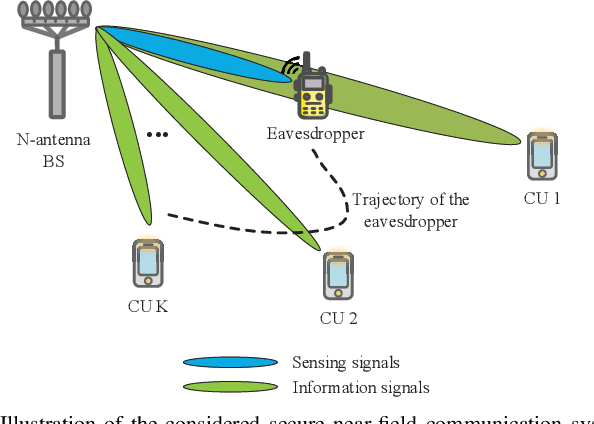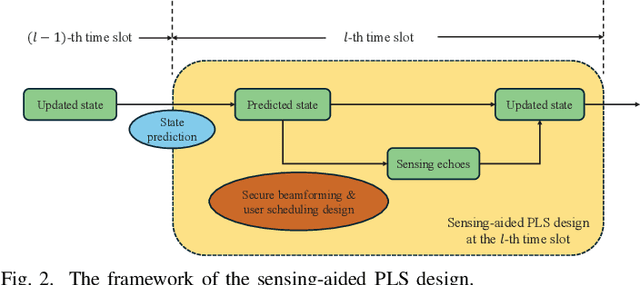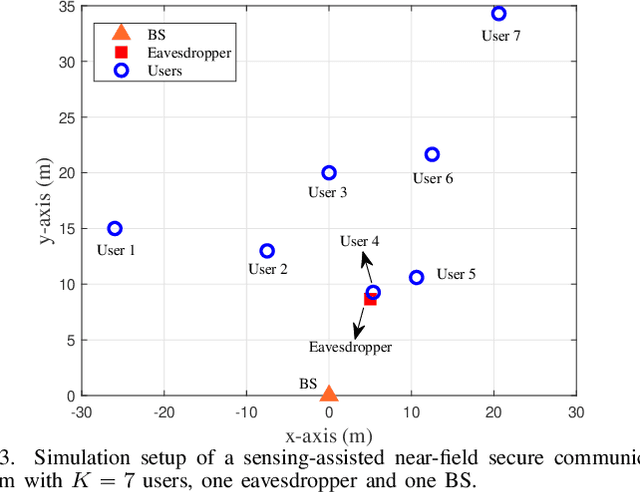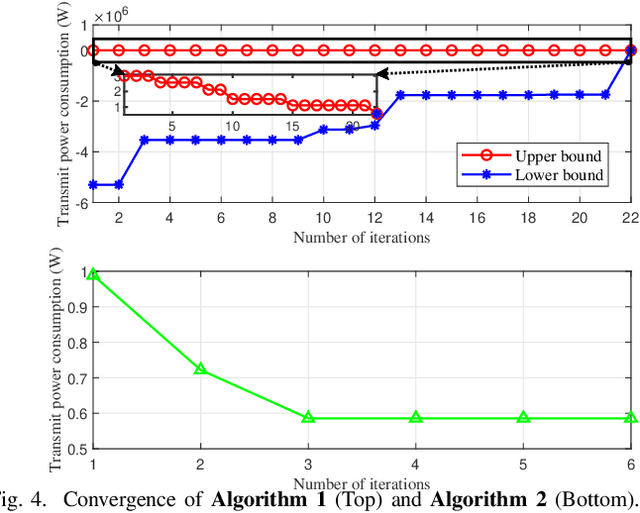Shenghui Song
Mutual Information-Empowered Task-Oriented Communication: Principles, Applications and Challenges
Mar 26, 2025Abstract:Mutual information (MI)-based guidelines have recently proven to be effective for designing task-oriented communication systems, where the ultimate goal is to extract and transmit task-relevant information for downstream task. This paper provides a comprehensive overview of MI-empowered task-oriented communication, highlighting how MI-based methods can serve as a unifying design framework in various task-oriented communication scenarios. We begin with the roadmap of MI for designing task-oriented communication systems, and then introduce the roles and applications of MI to guide feature encoding, transmission optimization, and efficient training with two case studies. We further elaborate the limitations and challenges of MI-based methods. Finally, we identify several open issues in MI-based task-oriented communication to inspire future research.
Communication-Efficient Distributed On-Device LLM Inference Over Wireless Networks
Mar 19, 2025Abstract:Large language models (LLMs) have demonstrated remarkable success across various application domains, but their enormous sizes and computational demands pose significant challenges for deployment on resource-constrained edge devices. To address this issue, we propose a novel distributed on-device LLM inference framework that leverages tensor parallelism to partition the neural network tensors (e.g., weight matrices) of one LLM across multiple edge devices for collaborative inference. A key challenge in tensor parallelism is the frequent all-reduce operations for aggregating intermediate layer outputs across participating devices, which incurs significant communication overhead. To alleviate this bottleneck, we propose an over-the-air computation (AirComp) approach that harnesses the analog superposition property of wireless multiple-access channels to perform fast all-reduce steps. To utilize the heterogeneous computational capabilities of edge devices and mitigate communication distortions, we investigate a joint model assignment and transceiver optimization problem to minimize the average transmission error. The resulting mixed-timescale stochastic non-convex optimization problem is intractable, and we propose an efficient two-stage algorithm to solve it. Moreover, we prove that the proposed algorithm converges almost surely to a stationary point of the original problem. Comprehensive simulation results will show that the proposed framework outperforms existing benchmark schemes, achieving up to 5x inference speed acceleration and improving inference accuracy.
Multi-Modal Self-Supervised Semantic Communication
Mar 18, 2025Abstract:Semantic communication is emerging as a promising paradigm that focuses on the extraction and transmission of semantic meanings using deep learning techniques. While current research primarily addresses the reduction of semantic communication overhead, it often overlooks the training phase, which can incur significant communication costs in dynamic wireless environments. To address this challenge, we propose a multi-modal semantic communication system that leverages multi-modal self-supervised learning to enhance task-agnostic feature extraction. The proposed approach employs self-supervised learning during the pre-training phase to extract task-agnostic semantic features, followed by supervised fine-tuning for downstream tasks. This dual-phase strategy effectively captures both modality-invariant and modality-specific features while minimizing training-related communication overhead. Experimental results on the NYU Depth V2 dataset demonstrate that the proposed method significantly reduces training-related communication overhead while maintaining or exceeding the performance of existing supervised learning approaches. The findings underscore the advantages of multi-modal self-supervised learning in semantic communication, paving the way for more efficient and scalable edge inference systems.
Remote Training in Task-Oriented Communication: Supervised or Self-Supervised with Fine-Tuning?
Feb 25, 2025Abstract:Task-oriented communication focuses on extracting and transmitting only the information relevant to specific tasks, effectively minimizing communication overhead. Most existing methods prioritize reducing this overhead during inference, often assuming feasible local training or minimal training communication resources. However, in real-world wireless systems with dynamic connection topologies, training models locally for each new connection is impractical, and task-specific information is often unavailable before establishing connections. Therefore, minimizing training overhead and enabling label-free, task-agnostic pre-training before the connection establishment are essential for effective task-oriented communication. In this paper, we tackle these challenges by employing a mutual information maximization approach grounded in self-supervised learning and information-theoretic analysis. We propose an efficient strategy that pre-trains the transmitter in a task-agnostic and label-free manner, followed by joint fine-tuning of both the transmitter and receiver in a task-specific, label-aware manner. Simulation results show that our proposed method reduces training communication overhead to about half that of full-supervised methods using the SGD optimizer, demonstrating significant improvements in training efficiency.
AI and Deep Learning for THz Ultra-Massive MIMO: From Model-Driven Approaches to Foundation Models
Dec 13, 2024Abstract:In this paper, we explore the potential of artificial intelligence (AI) to address the challenges posed by terahertz ultra-massive multiple-input multiple-output (THz UM-MIMO) systems. We begin by outlining the characteristics of THz UM-MIMO systems, and identify three primary challenges for the transceiver design: 'hard to compute', 'hard to model', and 'hard to measure'. We argue that AI can provide a promising solution to these challenges. We then propose two systematic research roadmaps for developing AI algorithms tailored for THz UM-MIMO systems. The first roadmap, called model-driven deep learning (DL), emphasizes the importance to leverage available domain knowledge and advocates for adopting AI only to enhance the bottleneck modules within an established signal processing or optimization framework. We discuss four essential steps to make it work, including algorithmic frameworks, basis algorithms, loss function design, and neural architecture design. Afterwards, we present a forward-looking vision through the second roadmap, i.e., physical layer foundation models. This approach seeks to unify the design of different transceiver modules by focusing on their common foundation, i.e., the wireless channel. We propose to train a single, compact foundation model to estimate the score function of wireless channels, which can serve as a versatile prior for designing a wide variety of transceiver modules. We will also guide the readers through four essential steps, including general frameworks, conditioning, site-specific adaptation, and the joint design of foundation models and model-driven DL.
Siamese Machine Unlearning with Knowledge Vaporization and Concentration
Dec 02, 2024Abstract:In response to the practical demands of the ``right to be forgotten" and the removal of undesired data, machine unlearning emerges as an essential technique to remove the learned knowledge of a fraction of data points from trained models. However, existing methods suffer from limitations such as insufficient methodological support, high computational complexity, and significant memory demands. In this work, we propose the concepts of knowledge vaporization and concentration to selectively erase learned knowledge from specific data points while maintaining representations for the remaining data. Utilizing the Siamese networks, we exemplify the proposed concepts and develop an efficient method for machine unlearning. Our proposed Siamese unlearning method does not require additional memory overhead and full access to the remaining dataset. Extensive experiments conducted across multiple unlearning scenarios showcase the superiority of Siamese unlearning over baseline methods, illustrating its ability to effectively remove knowledge from forgetting data, enhance model utility on remaining data, and reduce susceptibility to membership inference attacks.
Toward Real-Time Edge AI: Model-Agnostic Task-Oriented Communication with Visual Feature Alignment
Dec 01, 2024



Abstract:Task-oriented communication presents a promising approach to improve the communication efficiency of edge inference systems by optimizing learning-based modules to extract and transmit relevant task information. However, real-time applications face practical challenges, such as incomplete coverage and potential malfunctions of edge servers. This situation necessitates cross-model communication between different inference systems, enabling edge devices from one service provider to collaborate effectively with edge servers from another. Independent optimization of diverse edge systems often leads to incoherent feature spaces, which hinders the cross-model inference for existing task-oriented communication. To facilitate and achieve effective cross-model task-oriented communication, this study introduces a novel framework that utilizes shared anchor data across diverse systems. This approach addresses the challenge of feature alignment in both server-based and on-device scenarios. In particular, by leveraging the linear invariance of visual features, we propose efficient server-based feature alignment techniques to estimate linear transformations using encoded anchor data features. For on-device alignment, we exploit the angle-preserving nature of visual features and propose to encode relative representations with anchor data to streamline cross-model communication without additional alignment procedures during the inference. The experimental results on computer vision benchmarks demonstrate the superior performance of the proposed feature alignment approaches in cross-model task-oriented communications. The runtime and computation overhead analysis further confirm the effectiveness of the proposed feature alignment approaches in real-time applications.
Federated Low-Rank Adaptation with Differential Privacy over Wireless Networks
Nov 12, 2024Abstract:Fine-tuning large pre-trained foundation models (FMs) on distributed edge devices presents considerable computational and privacy challenges. Federated fine-tuning (FedFT) mitigates some privacy issues by facilitating collaborative model training without the need to share raw data. To lessen the computational burden on resource-limited devices, combining low-rank adaptation (LoRA) with federated learning enables parameter-efficient fine-tuning. Additionally, the split FedFT architecture partitions an FM between edge devices and a central server, reducing the necessity for complete model deployment on individual devices. However, the risk of privacy eavesdropping attacks in FedFT remains a concern, particularly in sensitive areas such as healthcare and finance. In this paper, we propose a split FedFT framework with differential privacy (DP) over wireless networks, where the inherent wireless channel noise in the uplink transmission is utilized to achieve DP guarantees without adding an extra artificial noise. We shall investigate the impact of the wireless noise on convergence performance of the proposed framework. We will also show that by updating only one of the low-rank matrices in the split FedFT with DP, the proposed method can mitigate the noise amplification effect. Simulation results will demonstrate that the proposed framework achieves higher accuracy under strict privacy budgets compared to baseline methods.
Sensing-aided Near-Field Secure Communications with Mobile Eavesdroppers
Aug 25, 2024



Abstract:The additional degree of freedom (DoF) in the distance domain of near-field communication offers new opportunities for physical layer security (PLS) design. However, existing works mainly consider static eavesdroppers, and the related study with mobile eavesdroppers is still in its infancy due to the difficulty in obtaining the channel state information (CSI) of the eavesdropper. To this end, we propose to leverage the sensing capability of integrated sensing and communication (ISAC) systems to assist PLS design. To comprehensively study the dynamic behaviors of the system, we propose a Pareto optimization framework, where a multi-objective optimization problem (MOOP) is formulated to simultaneously optimize three key performance metrics: power consumption, number of securely served users, and tracking performance, while guaranteeing the achievable rate of the users with a given leakage rate constraint. A globally optimal design based on the generalized Benders decomposition (GBD) method is proposed to achieve the Pareto optimal solutions. To reduce the computational complexity, we further design a low-complexity algorithm based on zero-forcing (ZF) beamforming and successive convex approximation (SCA). Simulation results validate the effectiveness of the proposed algorithms and reveal the intrinsic trade-offs between the three performance metrics. It is observed that near-field communication offers a favorable beam diffraction effect for PLS, where the energy of the information signal is nulled around the eavesdropper and focused on the users.
Resource Allocation Design for Next-Generation Multiple Access: A Tutorial Overview
Jul 03, 2024Abstract:Multiple access is the cornerstone technology for each generation of wireless cellular networks and resource allocation design plays a crucial role in multiple access. In this paper, we present a comprehensive tutorial overview for junior researchers in this field, aiming to offer a foundational guide for resource allocation design in the context of next-generation multiple access (NGMA). Initially, we identify three types of channels in future wireless cellular networks over which NGMA will be implemented, namely: natural channels, reconfigurable channels, and functional channels. Natural channels are traditional uplink and downlink communication channels; reconfigurable channels are defined as channels that can be proactively reshaped via emerging platforms or techniques, such as intelligent reflecting surface (IRS), unmanned aerial vehicle (UAV), and movable/fluid antenna (M/FA); and functional channels support not only communication but also other functionalities simultaneously, with typical examples including integrated sensing and communication (ISAC) and joint computing and communication (JCAC) channels. Then, we introduce NGMA models applicable to these three types of channels that cover most of the practical communication scenarios of future wireless communications. Subsequently, we articulate the key optimization technical challenges inherent in the resource allocation design for NGMA, categorizing them into rate-oriented, power-oriented, and reliability-oriented resource allocation designs. The corresponding optimization approaches for solving the formulated resource allocation design problems are then presented. Finally, simulation results are presented and discussed to elucidate the practical implications and insights derived from resource allocation designs in NGMA.
 Add to Chrome
Add to Chrome Add to Firefox
Add to Firefox Add to Edge
Add to Edge